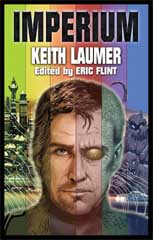
Worlds of the Imperium and its first sequel, The Other Side of Time, were some of the alternate history I read in the early 1960s—along with Lest Darkness Fall and The Man in the High Castle—that helped me discover the subgenre. Assignment in Nowhere, set in the same multiverse, came along a little later, and isn't a direct sequel to the first two: their protagonist, Brion Bayard, is a bit player in a drama that doesn't center on him.
I think H. Beam Piper, in his Paratime stories, was the first writer to show the vehicle that transported his characters from one timeline to another. Keith Laumer was the first, and I think still the only, writer to show you the Model-T version of a shuttle between timelines. His genius was to make this a nineteenth-century discovery by a pair of Italian scientists, Maxoni and Cocini. Anybody can do it. If you do it close to right, you can go from one alternate world to another on a wing and a prayer. But if you do it wrong . . . look out! There are uncounted timelines where they did it wrong, and trashed the planet with the energies they unwittingly unleashed. Oops!
In the midst of this Blight of ravaged alternate histories lies the world of the Imperium, where they did it right, and which has a tidy little trading empire with worlds far enough removed in probability never to have tried traveling between timelines at all. There is our world, where Maxoni and Cocini apparently never experimented, and there are a couple of others. Brion Bayard is kidnapped from our timeline by the Imperium to help solve a nasty problem stemming from one of those other worlds in the middle of the Blight.
Laumer was clever enough to see that a timeline which discovered a technology for traveling sidewise in time (to steal a title from Murray Leinster) would concentrate on that technology and ignore other possibilities. The traders and officers of the Imperium can scoot across the Blight with, if not the greatest of ease, at least relative safety in Worlds of the Imperium—but, even in the 1960s, they've never run into nuclear weapons. That's part of the trouble they're facing. The rest gets a lot more complicated: all kinds of toil and trouble for a double.
If anything, The Other Side of Time is even more convoluted than its predecessor. It's also much more audacious, and takes in a much broader swath of the multiverse. Turns out the Imperium isn't the only outfit able to go crosstime after all—and the others who can do it aren't human at all. They're the evolved descendants of the hairy hominids that we Homo saps exterminated in this sheaf of timelines—and they look down their (flat) noses at us because we did. To add injury to insult, they've been traveling across the timelines longer than the Imperium has, and their shuttles are considerably more sophisticated than anything mere humans can manufacture. Some of them—the Hagroon—have in mind wiping out the Imperium's timeline altogether, and doing it retroactively so the line was never there at all. Others don't approve of this, which still doesn't mean they have any particular use for people as we know them. Figuring out who's doing what to whom, and why (and staying alive in the process, which ain't easy), is Brion Bayard's task here. He pulls it off with panache, and considerably complicates anthropologists' lives on quite a few timelines.
In Assignment in Nowhere, Laumer's headlong narrative drive—always one of the strongest features of his writing—almost gets out of control. Johnny Curlon is a man from our timeline taken by the Imperium to help mend a probability storm heading out of the Blight that threatens all the surviving lines within it. He is also, it turns out, the last surviving scion of the great Plantagenet family, a distant relative of Richard the Lion-Hearted, which was of great importance in the worldlines destroyed by the Blight. He is both aided and opposed by Baron General van Roosevelt, Acting Chief of Imperial Intelligence. How and why did Plantagenets and Roosevelts get to know each other across the timelines? What connection is there between this van Roosevelt and the Roosevelts of our world? The proof is left for the student, as geometry texts used to say; Laumer never explains. But even though the underpinnings may be shaky, the story never flags, and you'll keep turning pages from first to last.
Taken all together, these three novels can't add up to more than 140,000 words: only a medium-sized book by today's standards. But Laumer puts enough interesting ideas in them for not just three but six or eight modern doorstoppers. And he doesn't stint on characterization or dry wit, either. I had an enormous amount of fun rereading these for this introduction. If you've been around a while and run into them before, you'll enjoy them again, too. And if this is your introduction to Keith Laumer's work—well, hold on to your hat, because it's quite a ride.